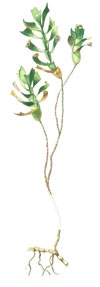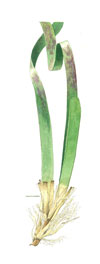Seagrass Species Guide
Seagrass Species
Comment
Image
Amphibolis antarctica
The most common species in Shark Bay covering 85% of the seagrass area. Grows from the low tide mark to as deep as 13 metres. Lives in a variety of sediment types. Can be very dense forming 300 – 500 shoots per metre.

Posidonia australis
The second most common species in the bay forming monospecific stands largely in channels. Doesn’t like saline waters – rarely found in water with a salinity above 50 parts per thousand. Only has about half the production rate of Amphibolis antarctica.

Halodule uninervis
Apart from the 2 species above it is the only other species in the bay to form monospecific stands eg at mouth of Wooramel delta, an important summer feeding ground for dugongs. Rhizome of this species is rich in starches. Can be found at high salinities of 62 parts per thousand but in low numbers. Grows rapidly.

Cymodocea angustata
Wide leaved tropical species found no further south than Shark Bay. Endemic to the northern section of the Western Australian coastline and common in Shark Bay.

Cymodocea serrulata
Tropical species with strap like leaves 5 to 9mm wide. Only found in small numbers in Shark Bay.

Halophila decipiens
Has small translucent oval leaves. Found in low densities in Shark Bay.

Halophila ovalis
Narrow leaved species. Can grow on the intertidal flats in sparse mixed stands with Halodule uninervis and Halophila minor. These stands are the preferred grazing area for dugongs. Grows rapidly.

Halophila minor
Narrow leaved species. Mixed stands with H. ovalis and Halodule uninervis are preferred dugong food source.

Halophila spinulosa
Below depths of about 8 metres forms very dense stands of up to 800 shoots per square metre.

Posidonia coriacea
A southern Australian endemic that grows with a clumping habit in areas of relatively high wave energy. Not common in Shark Bay.

Syringodium isoetifolium
Wide leaved species found in small numbers in the bay. A tropical species found no further south. Grows in small areas of high productivity with a number of other species creating a food source for dugongs.

